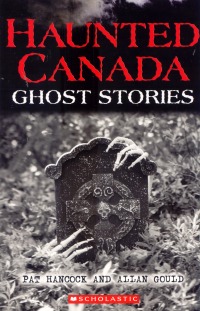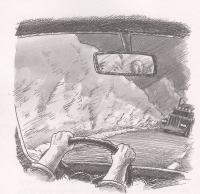| ________________
CM . . .
. Volume XX Number 39. . . .June 6, 2014
excerpt:
Haunted Canada Ghost Stories is a collection of 15 eerie tales. The protagonists are typically preteens with a problem, such as trouble with school or a bully. The ghosts are largely benign and spurred on by their own tragic demise to act as guardians to save others from a similar fate. Each story is narrated in the third-person and runs around eleven pages in length. The vocabulary is friendly to young readers.
Ashley and her horse, Sam, are similarly endangered by the outdoors in “Golden Eyes”. Ashley offers a silent girl with golden eyes a ride to shelter only to find that it was she who was rescued from the elements that killed her mysterious companion. “Game Boy” is one of the more overtly didactic stories in this collection. A boy who prefers video games to math is befriended and taught a lesson – in more ways than one – by a boy whose lifespan was prematurely abbreviated by disease. One of the more creative tales in this collection, “A Dream Come True”, features two adults searching for the friendly white house their daughter has dreamed repeatedly of. Sweet and charming. A victim and his bully learn to get along at summer camp with the help of a dead dog in “A Boy’s Best Friend”. In “Robber’s Reward”, it is a newly-made ghost who needs the help of an empathetic girl. The ghost in “Rescue by Numbers” is off-scene for the whole story, yet enables an injured boy to save his father long-distance via a possibly possessed paint-by-numbers kit. “The Raven” is creepier than most of this collection. Cito likes the library (librarians may like the portrayal of the helpful and competent Miss O’Toole) until it displays a stuffed raven believed to be the one immortalized by Edgar Allen Poe. The raven’s ominous presence begins to haunt Cito. Disappointingly, however, Cito has no effective agency; he is chosen by the raven as its next victim and saved by an accidental fire. He has no say in his own destiny. A baseball fan becomes increasingly fanatical about his game rituals and winds up being possessed by his own superstitions in “Bottom of the Ninth” which features no actual ghosts. This tale is overtly didactic and ends with the boy rejoining his father and brother for the communal experience of watching sports for fun. “The Empty Place” also replaces ghosts with personal oddities when Kit becomes trapped by her own goal of finding a truly empty place. She is ultimately rescued from her game and led home by a hawk which she had earlier resented. Kit’s time away from her family leads her to a renewed appreciation in this story which contains a more self-aware protagonist and internal development than most of the others in this collection. Friendly ghosts return center stage in “Password to Mystery” in which Vinnie attempts to make sense of his little sister’s story of how a mysterious woman picked her up from school and kept her away from home – just long enough that Jasmine did not die in the fire that destroyed her house’s garage that afternoon. Raffi’s attempt to be friendly to “The Newcomer” at school backfires when Damien ends up mirroring his every move, even saying what Raffi thinks before it comes out of his mouth and taking control of Raffi’s thoughts. Raffi’s dad has helpful advice about bullies, but it is Raffi who figures out how to get the best of Damien. “Night Games” details the adventures of Luke who is finally allowed to stay home alone for an evening and whose mind is filled with his older sister’s horror stories. Despite his rising terror, Luke faces down every “monster” that menaces him. The ending is anti-climactic; the monster Luke fears most is finally and incontrovertibly proven to be real, and yet nothing appears to happen. In another new kid/bully scenario, Joey’s friend Mario has it out for Lillian whose family moves into an old, supposedly haunted house. Mario launches a campaign of rumours and pranks which culminate on Halloween when he snatches her bag of candy. Joey finally stands up to Mario and finds out that Lillian doesn’t need his help, but welcomes a friend anyway in this clever tale. “Life Guard” features another older brother looking out for his younger sister in what is arguably the eeriest tale of the collection. Raymond and Angelina are glad to have a week at the cottage their father is repairing while their mother is away. Things would be perfect for this close-knit family if it weren’t for this lady with the yellow hair whom Angelina reports watching her. This ghost wants a daughter. The few black and white illustrations fittingly emphasize shadows, but they do not extend the tales as a whole. The sketch for “Life Guard”, however, breaks from the text by depicting the ghost, which the boy protagonist never sees, although his younger sister does. Despite multiple literary references and a few characters who love reading (Ashley names her horse Sam after the hobbit in The Lord of the Rings, for instance, and authors Gordon Korman and Daniel Pinkwater are mentioned in another story), these ghost stories are simple and lack verve. Characters remain fairly flat, and development tends to follow didactic rather than creative lines: protagonists learn their lesson and survive, but they don’t linger in the reader’s mind as personalities. Emphasizing the skin-tingling creepiness of the events, rather than the characters involved, may be a feature of short horror stories, however, and a few of the tales had a touch of charm despite being spare. Much less frightening than the “Goosebumps” series, Haunted Canada Ghost Stories is an easy introduction to horror for younger readers. Recommended. Janet Eastwood is a student in the Master of Children’s Literature program at the University of British Columbia.
To comment
on this title or this review, send mail to cm@umanitoba.ca.
Copyright © the Manitoba Library Association. Reproduction for personal
use is permitted only if this copyright notice is maintained. Any
other reproduction is prohibited without permission.
NEXT REVIEW |
TABLE OF CONTENTS FOR THIS ISSUE
- June 6, 2014.
AUTHORS |
TITLES |
MEDIA REVIEWS |
PROFILES |
BACK ISSUES |
SEARCH |
CMARCHIVE |
HOME |

 In “The Sleeping Boy”, passengers panic when a bus is hijacked by an unknown and unseen entity. When the bus and several similarly treated vehicles end their terrifying ride in a remote village, an old man warns the passengers that they were brought there by the Sleeping Boy of Silver Lake who guards the region to prevent anyone else from natural disasters like the one that killed him. The old man’s story is initially dismissed and subsequently proven true by an avalanche that covers the roads yet not the village. The story reads like an example of the local lore which it establishes.
In “The Sleeping Boy”, passengers panic when a bus is hijacked by an unknown and unseen entity. When the bus and several similarly treated vehicles end their terrifying ride in a remote village, an old man warns the passengers that they were brought there by the Sleeping Boy of Silver Lake who guards the region to prevent anyone else from natural disasters like the one that killed him. The old man’s story is initially dismissed and subsequently proven true by an avalanche that covers the roads yet not the village. The story reads like an example of the local lore which it establishes.